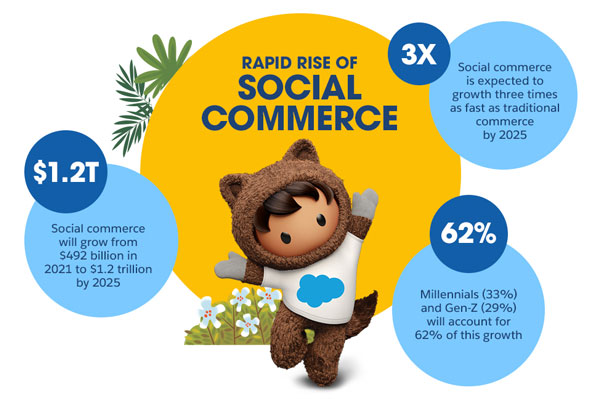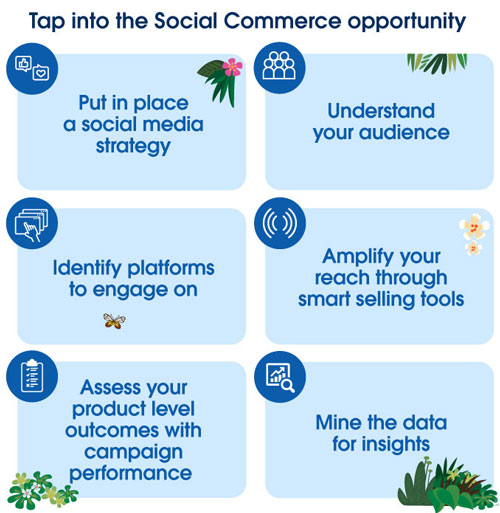Social media adoption, consumption, and engagement across Gen Z and Millennials is on the rise. Indians constitute a significant proportion of this global audience whose tastes, opinions, and desires are increasingly being shaped by social platforms.
Today, as many as 467 million Indians are active social media users. They spend an average of 2.36 hours on social platforms daily. Many use these platforms to interact, get inspired, and fulfil their growing need for social affirmations or validations.
Social media is also becoming a one-stop destination for product discovery, search, shopping, purchase, and post-purchase support. This shift towards social commerce has the potential to revolutionise shopping experiences, and create new opportunities for brands to increase their sales revenue.
What is social commerce?
Have you ever followed a celebrity or friend, say on Instagram or Facebook, and seen them endorse a certain brand? Did that prompt you to visit the brand’s online shop, scroll through the products, and make a purchase? If yes, you have engaged in a form of social commerce.
Social commerce is the coming together of social media and online shopping. Sellers can use social media to promote their products, while shoppers can use it to search for and engage directly with brands. Most social commerce transactions take place entirely on a social media platform – so, click-through ads that take shoppers to a brand’s own website don’t qualify.
Here’s what’s driving social commerce’s exponential growth in India:
- Access to affordable smartphones and data
- Increased awareness and understanding of consumer needs
- Seismic shift to online shopping
- Consumers’ trust in social validation around online purchases
- Growing demand for convenience and personalisation
- Rising need for assisted commerce to bring in the next set of online shoppers
- A surge in entrepreneurship, seller empowerment, and creator ecosystems
Social commerce in India sees engagement at three levels:
- Content created by brands, influencers, or consumers that triggers discovery and purchase (e.g., shoppable posts on Instagram, live or video commerce, chat-led commerce)
- Experience-led immersive or interactive shopping journeys (via gamification, AR-VR, or live streaming)
- Network or community-based commerce that drives sales and earns sellers bulk discounts (e.g., group buying, social reselling)
Opportunities abound, both globally and in India

China remains the most advanced market for social commerce with 2021 sales forecast to reach $363 billion or ~13% of online retail sales. This momentum has been driven by three deeply entrenched social platforms in China, each with a different model at play:
- Xiaohongshu – Instagram, Pinterest, and Amazon in one!
- WeChat – a ‘super app’ with a mix of features across Instagram, Facebook, integrated payments systems, and ecommerce apps
- Pinduoduo – social commerce for the price sensitive consumer, combining group buying with ecommerce
So, will India follow China and build a booming social commerce market?
The answer is most likely, yes. Many of the success drivers that shaped China’s social commerce story exist in India too. They include a massive user base, a growing creator ecosystem, the proliferation of payment gateways, the rise of short-video platforms, availability of vernacular networks, and innovations around monetisation models.
From FY 20-25, social commerce in India is expected to grow at 55-60% CAGR, taking the current market size from $1.5-2 billion to $16-20 billion.
Popular social commerce platforms in India include:
- Meesho – Based on the concept of social reselling, Meesho is based on an assisted shopping model. The app empowers women entrepreneurs and the reseller ecosystem to cater to the needs of Tier II cities and beyond. It starts with a reseller sharing a product through WhatsApp or Instagram; the customer then places an order, and Meesho delivers it.
- Trell – This influencer-led social commerce platform enables consumers to purchase products based on video content generated by content creators. The site reportedly has over 50 million monthly active users.
- Roposo – Roposo focuses on creator-led live commerce. Creators can run their own pop stores, while users enjoy premium entertainment shopping experiences.
- Moj – Short video platform, Moj, recently joined hands with Flipkart to help consumers buy Flipkart-tagged marketplace products directly from the video screen. Moj has a monthly active user base of over 160 million.
- Myntra – The ecommerce giant has accelerated their social commerce investments with the launch of ‘Style Squad’, in addition to M-Live and Myntra Studio. Style Squad is positioned as a cohort of content creators or influencers who will partner with Myntra to drive content-led commerce by engaging with fashion- and style-conscious Gen Z’ers and Millennials.
Jump on the Social Commerce trend
Turbo-charging online shopping in India
While search led ecommerce brought in the first wave of online shopping, the next wave will be powered by discovery, engagement and interaction-led social commerce.
The number of ecommerce shoppers in India has grown to about 190 million, thanks to increased smartphone usage and lower data costs. However, the number of social media users, as we saw earlier, is far greater. That presents a significant opportunity for businesses to find more shoppers, and drive more sales.
The depth and reach that social media provides makes it an attractive choice for brands to target the next set of consumers, and test new models of commerce.
What can brands do to tap into this opportunity?

- Put in place a social media strategy: Today’s customers turn to an average of nine channels to browse inventory, seek advice, and make purchases. To engage them effectively, build a cohesive and unified ecommerce experience across channels – be it social media, email, video chat, or messenger apps.
- Understand your audience: Who are they, what do they seek, where do they access information, who inspires them, and which channels do they use to find products? Knowing the answers can help you develop a clearer roadmap of where to focus your social commerce efforts.
- Identify platforms to engage on: Consider both your existing and potential customers. Ensure that you’re reaching them across all touchpoints and channels that they’re on. Identify effective ways of engaging - be it through live videos, custom graphics, or user generated posts.
- Amplify your reach through smart selling tools: With intelligent CRM software, you can tailor content to your audience, and automate your marketing communication. CRM tools also help you move prospects along your funnel seamlessly, and manage all your customer data in a single source of truth.
- Assess your product level outcomes with campaign performance: Integrating solutions like Marketing Cloud Intelligence with the Salesforce Order Management System (OMS) can help you understand the relationship between product-level order outcomes from Salesforce OMS — such as sales, return, and revenue — with campaign performance. Meanwhile, the Social Intelligence App for Datorama can help you track your social media performance, and understand how your brand presence compares to competitors.
- Mine the data for insights: Tools like Einstein AI for Commerce Cloud can help you use consumer data to improve conversions, offer tailored product suggestions, provide personalised customer support, and more. We’ve seen brands increase sales by up to 10% with Einstein.
The future looks bright
In the coming years, social commerce adoption in India is likely to rise as consumers place greater trust in user generated content over traditional marketing. Social commerce platforms that invest in technology (like AR/ VR) with the ability to understand and tap into specific customer segments will continue to thrive. More brands will want to partner with such platforms to expand their reach and keep up with consumer demands.
Furthermore, the coming together of video, voice, and vernacular language apps will help social commerce penetrate deeper into the Indian market. These trends, coupled with a booming creator economy, will pave the way for more players to leverage the attractive proposition of social media and commerce.





